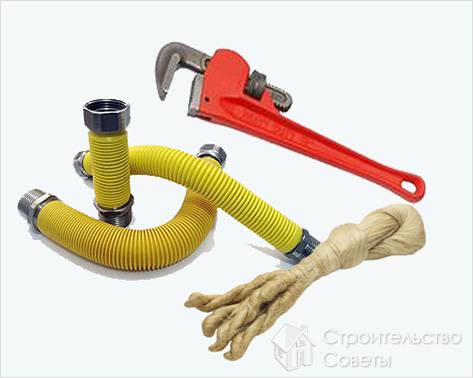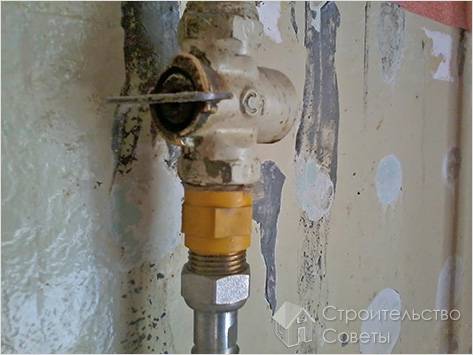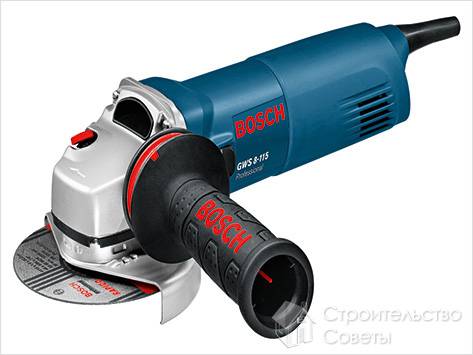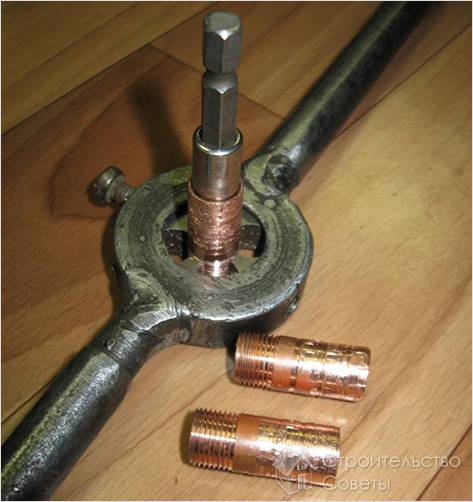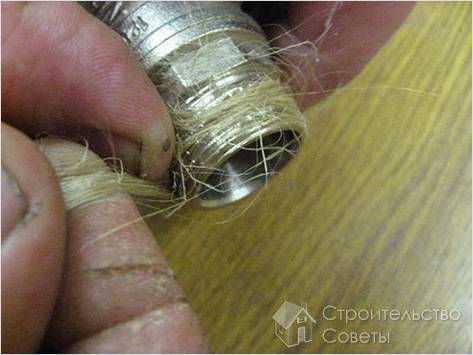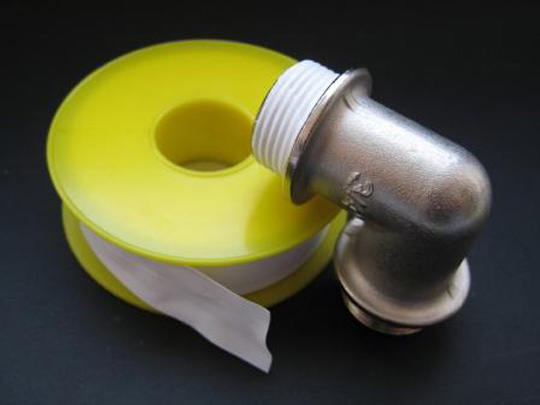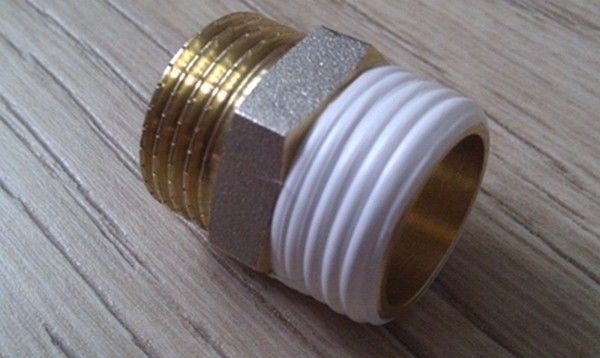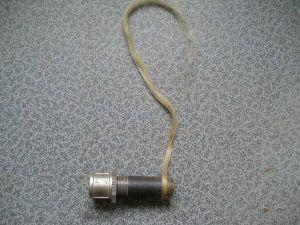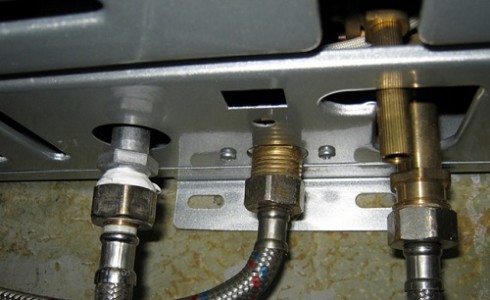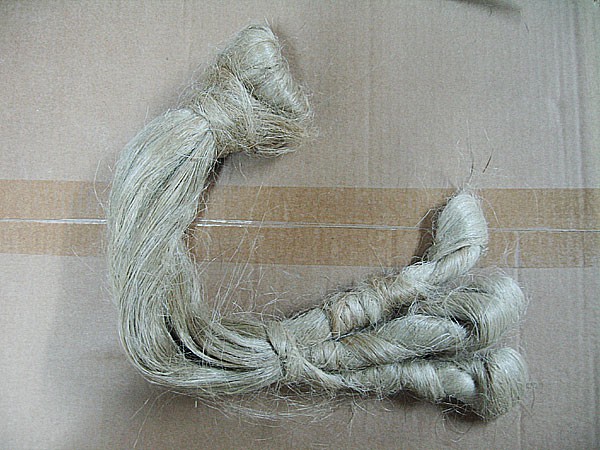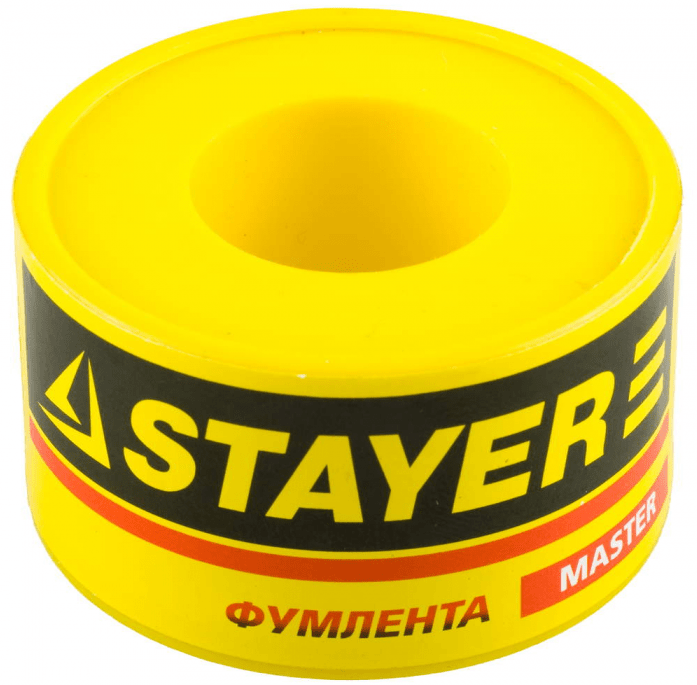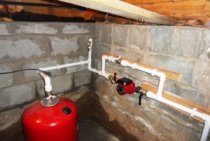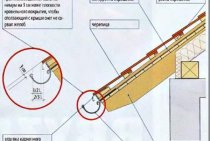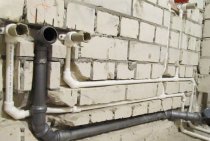Types of pipe connection
There are several basic ways to connect gas pipes, to be exact:
- Welding - carried out exclusively by specialists who have permission to work with a welding machine. Each employee must have a personal identification card.
- Threaded or fitting - also includes welding of light pipes, while the sockets are sealed with hemp fiber. The whole process of work very much resembles the connection of sewer pipes. It should be noted that the fiber is pre-impregnated with a solution of linseed oil or drying oil. You can also use couplings that can have both long and short threads.
- Flanged is one of the most common connection methods, as it has a fairly light assembly design. True, according to experts, it is less reliable than welding.
All of the above connection methods are used by professional craftsmen using specialized equipment.
In order to independently connect gas tubes in a house or apartment, you need to prepare the following tools and materials:
- gas wrench;
- tow and lubricant;
- hoses or pipes connections;
- if necessary, a connector having a thread on both sides.
If you shut off the gas supply and blew the pipes, as recommended earlier, then the next step is to cut off the unnecessary parts of the gas pipes. To do this, you can use a grinder, and if one is not available, then a hacksaw is quite suitable, but in this case the process will be lengthy and more complicated.
After you have removed the unnecessary part of the gas pipe, you need to carefully weld or solder one end of it.
If you need to connect one end of the pipe to a gas hose, then you will need to cut the threads on the sawn part. To do this, there is a special nozzle, putting on which, you will need to scroll several times.
Next, tow is wound on the thread made, which is impregnated with grease and connected to the hose. All these works are carried out using a gas wrench. If you plan to install a new pipe, then you can use a special connecting adapter. This element has a finished thread and a nut on both sides, which is screwed on the main and on the new pipe.
This method can be used in residential premises, you just need to make sure that there are no leaks. To do this, you need to open the gas supply, and then apply soapy water to all pipe joints.
If you have never done such work yourself before, it is best to entrust this matter to professionals.
Sealing domestic air ducts
Ventilation in apartments and country houses is carried out by thin-walled elements. Often, air ducts are made of rectangular section or from corrugated pipes. Threading on these connections is not possible. Therefore, the sealing of ventilation joints is carried out in other ways:
- through the flanges
- bandaging,
- socket method with the insertion of one air duct into another.
Flange connection is most often used for non-circular ducts. Sealing is carried out using gaskets made of a soft material, such as porous rubber. The shape of the gasket should follow the cross section of the duct.
With other methods, the voids formed after joining the air ducts are filled with mastics, according to their temperature characteristics corresponding to the operating conditions of the air line. Sometimes the joint of the air ducts is wrapped with self-adhesive tape.
 Bandage clamps used for joining round ducts
Bandage clamps used for joining round ducts
Application of FUM
FUM tapes and threads are used for sealing threaded connections of hot water supply (DHW), heating systems (CO) and cold water supply (CW). They are also used when connecting gas appliances to a gas pipeline.
Fluoroplast is a plastic and strong material with a melting point above 400 degrees, resistant to oxygen and aggressive liquids. The thread and tape fill in the unevenness of the thread and ensure the sealing of the joint. Sealing FUM tapes are produced with a width of 10-16 mm and a thickness of 0.08-0.12 mm., FUM threads - with a diameter of 0.4-1.5 mm. With temperature changes and vibrations, the FUM is deformed, and the threaded connection leaks.
The thickness of the tape winding depends on the diameter of the pipe and the thickness of the tape. For pipes with a diameter of up to 20 mm, 2-3 layers of tape with a thickness of 0.12 or 1-1.5 layers of thread are wound. For pipes with a diameter of up to 40 mm, 5-6 layers or 2-3 layers of thread are wound. For pipes with a diameter of over 40 mm, 8 or more layers of tape or 5 or more layers of thread are wound. For main pipelines, it is preferable to use tapes with silicone mastics.
If the thread is covered with rust, the thickness of the winding is doubled. Before winding the tape, the threaded connection is cleaned with an iron brush and blown with compressed air. Tape and thread are wound on a pipe or fitting thread in an interference fit with a force of 0.5-1 kg clockwise. To seal the threaded connections of gas appliances, they are wound counterclockwise.
Wind with a cone from the edge of the connection. If holes and damage are visible on the threads after cleaning from rust, use a different sealant. FUM is used to seal intact threaded connections.
Do not use FUM to seal heating pipes. Temperature fluctuations will damage the FUM, the connection will leak, and water or steam leaking from the heating system will cause burns.
Is FUM tape used for sealing steam and water heating pipes? No, experienced plumbers seal such connections only with flax (tow) and sealant.
Tape winding on pipe thread
This operation is always performed on the outer thread. If a repair is being made with the replacement of a fitting, the pipe thread must be thoroughly cleaned of dirt and rust, degreased using acetone or white spirit, dried in air for about 10 - 12 minutes. How to use the pipe jar to ensure its effectiveness:
- the seal must be wound onto the thread from its rear end;
- the FUM tape is superimposed in the direction of its descent, that is, its end should be located in the direction of screwing the fitting;
- winding is carried out with a tension that ensures a tight fit of the pipe thread profile, it is better to allow the tape to break than to perform loose winding;
If there are no such notches, they must be made independently.
Tape FUM for pipes is a modern and most commonly used means for sealing joints in pipelines for various purposes. FUM cord products that have appeared in recent years do not provide any special advantages either in application technology or in efficiency.
To understand how to use FUM tape for gas pipes, you need to take into account the characteristics of the material and apply it in an appropriate way.
Watch the video
Alternative materials - linen tow
Various seals are used, which include bast fibers in the form of strands and various sealants.
One of the first sealing materials that have found wide application in the installation of pipelines is tow. This is the name used to this day for flax fibers in the form of strands wound on the external thread of a pipe.
At the same time, it is important to wind it carefully in turns with filling in the full cutting profile. For more reliable sealing, the winding of tow is covered with additional materials, from thick paint to specially designed sealants.
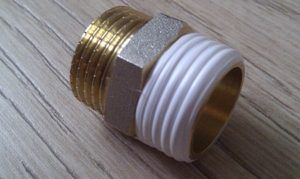
- the ability to adjust the interface at the location - it is allowed to unscrew the fitting in the opposite direction at an angle of up to 45 degrees without loss of insulating properties;
- sufficiently reliable tightness and ability to absorb moisture;
- the joint is resistant to mechanical stress;
- facilitated dismantling of the joint.
The disadvantages include a tendency to decompose as a result of putrefactive processes, since the material belongs to organic products.
Video
There is no single answer to the question of choosing a method for sealing a threaded connection. The undoubted advantage of using the tape is the connection of cantilever elements, such as taps or mixers, pipe couplings are best done with sanitary tow.
Sealants
Not only increases the impermeability of the connecting area, but also significantly increases its ability to withstand mechanical stress
What is very important in pipeline systems due to constant vibration effects and water hammer
The sealant cures on contact with air or the mating surfaces of the threaded joint, acting as an adhesive and turning the assembly into a solid piece.
The most common way to classify is by color, and there are two main positions for this division:
- blue - represents medium strength sealants. Able to significantly reduce the intensity of the thread loosening process. In practice, for the most insignificant weakening of the joint, a long-term exposure to serious loads of a sign-changing nature will be required. But when using blue sealants, it is still possible to turn the thread, albeit with great difficulty;
- when using red sealants, such an operation without heating does not seem realistic. With such a gel, the structure is simply glued together. For the pipeline it is used in places with strong vibrations (from pumping equipment) and, if possible, water hammer.
Conclusion
FUM tape for gas pipes is one of the main ways to seal joints during pipeline installation. The methods outlined here on how to use a gas pipe holder take into account all the main features of the material, but do not exclude the performer's creative approach to this important operation. At the same time, it is necessary to understand that the gas pipeline is a source of increased danger.
Video
The fight against leaks
Fixing a leak in a heating system with a sealant is a chemical leak control.
The specified German sealant proved to be excellent in solving this dilemma. Also used are the following:
- Resins with two components based on epoxy.
- Adhesive silicone compounds.
- Heat-resistant compositions based on rubber.
Their algorithm:
- The damaged area is degreased, dried, covered with a thin layer of sealant.
- Then she is wrapped with a sickle. Serpyanka reinforces the sealed layer.
- Already the sickle is covered with sealant. The action is repeated.
If a silicone product is used, then abrasives should not be used to grind the damaged area. And this type of sealant sticks better to a smooth surface.
Welding of gas pipelines
Welding of gas pipes under pressure is carried out by highly qualified welders who have certificates for such work.
Arc manual welding and resistance welding do not provide reliable corrosion resistance of the joint area
, only the pressure welding method eliminates these disadvantages.
Welding in a special welding machine takes place in the following way:
- the pipe is fed along the rollers until it stops at the stopper of the immovable clamp and there the pipe is clamped. The supply of the second pipe is carried out until it stops in the first pipe, then the movable clamp is clamped;
- a special mechanism regulates the edge difference and a preliminary pressure is created in the joint through the movable mechanism;
- by longitudinal and transverse movement of the supports of the heating unit, the inductor is first adjusted to the joint and then closed;
- turn on the induction heating source, and when the welding temperature is reached, the time relay will turn off the heating source;
- the time for welding one joint is given no more than one minute;
- a command is given to upset the welded pipes, after upsetting the clamping devices are released, the movable clamp returns to its initial position and the installation is ready to accept a new pipe.
This welding method is used in the gas industry to connect black pipes and pipes with an internal anti-corrosion coating.
Gas sealant requirements
In order to completely eliminate gas leakage at the connecting points of the gas pipeline system, it is necessary that the winding meet the following requirements:
- resistance to vibrations of various intensity;
- resistance to sudden changes in temperature and internal pressure;
- protection of the connection from the formation of a corrosive coating;
- ease of installation and dismantling in case of repair;
- strength and long period of use.
All sealing materials must be checked by specialists for strength and certified for use in gas supply systems.
Types and conditions of sealing
It is necessary to isolate joints when laying pipes for different types of pipelines. The only exception is welded joints, but this is also their disadvantage - they are one-piece. And the threaded joints make it easy to replace a damaged area or insert a new strapping.
Therefore, sealing is necessary for threaded pipe connections:
- hot and cold water supply,
- gas pipelines,
- heating.
In practice, the thread is used in small-diameter highways - in internal wiring at home and in an apartment, country cottages and when laying networks to detached buildings with low water and gas consumption. Flanged connections and welding are used for large-diameter water supply and heating pipes.
Ventilation lines, as a rule, have a large cross section and are made of thin-walled sheet or corrugated pipes. Therefore, threaded connections are not used in them, but sealing of the joints is still necessary.
When choosing a method for sealing pipe joints, it is necessary to take into account their properties and the conditions in which they will function:
- External temperature of the medium and internal carrier in the pipeline. Some types of sealants lose their properties at elevated temperatures or in the cold.
- Line pressure. Liquid insulators can be squeezed out of the connection at high pressure.
- Pipe diameter.
- Final bond strength. This is the force required to disassemble the insulated joint in case of its repair or rewiring.
- Environmental Safety. When laying pipelines for drinking water, do not use substances that can release toxic compounds.
Most of the means and substances used for sealing, according to these parameters, fit into the range required for joining household pipelines. But especially careful choice is necessary when sealing the joints of gas pipes. Violation of tightness in water lines is noticeable from the very beginning by the traces of leaks at the joints. Gas leaks are not visually evident and may remain undetected for a long time.
Features of installing an exhaust pipe for gas appliances
When installing gas heating appliances, as well as oil radiators, it is necessary to pay due attention to the issue of competent organization of the removal of combustion products from the premises.And this is right, because, in addition to creating a safe environment for humans, they increase the efficiency of the heating devices themselves, contribute to their more productive and economical operation.
To determine the diameter of the gas outlet channel, it is necessary to take into account:
- The amount of combustion products.
- Power of heating devices.
- The temperature difference between the outside air and the products of combustion.
- Chimney pipe height.
Installation of exhaust pipes for gas appliances, in accordance with the rules, is carried out next to the internal walls and near partitions made of non-combustible materials. If necessary, they can also be installed in external walls, also from non-combustible materials. In this case, in order to avoid the appearance of condensate during the removal of combustion products, the walls are insulated from the outside. If there is no wall in the room that is suitable for accommodating chimneys in it, a root or extension pipe for a gas appliance must be used.
Pipes should be as open as possible.
Installation of gas appliances that do not have a connection to the chimney duct is carried out exclusively in a place where at least 5 m3 of free space will be allocated for each burner. For a small water heater that is not equipped with an exhaust gas combustion product, it is necessary to allocate at least 6 m3. A geyser for a shower room or bathroom must have an exhaust for gas combustion products and a free space of at least 10 m3.
If there is not enough volume in the room where the gas stove is being installed, then a ventilation outlet must be made above it. Since gas appliances use the air from the combustion room, it must be provided with free access. For this purpose, a small gap is left under the floor door (the area of the gap is derived from the calculation: for every 1000 kcal / h of gas appliance power, at least 10 cm2 is needed).
All appliances for heating, gas water heaters, etc. are equipped with a fuse to shut off the gas in the event that the fire goes out.
Installation of gas heaters should always be carried out with a connection to the chimney in all cases, except for one: if it is a heater with a closed combustion chamber. Then the removal of combustion products and the air supply to the burner are separated from the room. To the chimney, the cross-sectional area of \u200b\u200bwhich is 200-220 cm2, you can connect a pair of gas appliances to one floor with a gas flow rate of 8 m3 / h. The distance between the chimney inlets in height must be at least 30 cm. To connect four gas appliances from one apartment with a gas flow rate of 12 m3 / h, a chimney with a cross-sectional area of \u200b\u200bat least 300 cm2 is needed on the same floor. The connection of gas appliances with one chimney on different floors is unacceptable.
The chimneys of gas appliances are located above the roof in the same way as conventional chimneys. When during the reconstruction of the house it is impossible to use the old stove chimney to remove gas combustion products, a new chimney is made from pipes that are connected to the rear facade of the house. These pipes are made of galvanized steel sheets, and, unlike pipes for the removal of combustion products of liquid and solid fuels, they are connected by joints that are directed in the opposite direction from the movement of gases.
During repair or rebuilding, when the tightness of gas pipelines may be broken, it is necessary to check their integrity upon completion of work. For this purpose, air is let into the pipes at a pressure that is twice the pressure that is needed in them during the passage of gas (approximately 500 mm of water column).
Before checking, you need to block the taps. If within five minutes the pressure in the pipes drops by more than 20 mm of water. Art., then you need to look for damage in the pipe (the alleged places of damage must be moistened with soapy water).The gas pipeline for liquid gas is checked for tightness in the same way under a pressure of 1200 mm of water. Art.
Threaded connections are applied to pipes, as well as to connecting and branch fittings. But the simplicity and reliability of connecting any pipelines using threading still does not ensure its complete impermeability. Therefore, a mandatory addition is the sealing of pipes in all places of threaded joints. Only this combination allows you to create a reliable connection.
natural seals
Jute and tow are used in conjunction with silicone sanitary sealants. The thread is cleaned of dirt and rust, coated with sealant, the sealant is twisted into a thread and wound clockwise flush with the thread crest. When winding, the seal is pulled with a force of 0.5-1 kg.
After winding, carefully coat with sealant and assemble the joint. Within 5-8 minutes, until the polymerization process is completed, it is necessary to check and, if necessary, tighten the connection more strongly. Tightening the nut after the sealant has cured will cause leakage.
Stores sell ready-made plumbing thread for sealing pipes, made from flax. It doesn't need to be twisted. Before you buy a thread, read on the package what it is made of and whether it contains silicone or acrylic sealants. If this thread is made of fluoroplastic, it is undesirable to use it on damaged threaded connections, if it is vegetable thread without sealant, then purchase a separate sanitary sealant.
The owners of apartments and houses ask: “Which thread is better for pipes?”, meaning the brand. To which a professional plumber will answer: "Better is the thread that was skillfully wound."
If the thread is more or less than necessary, or it is not wound along the thread, the connection will leak. Do not wind it "with a margin", wind it as much as you need and do not forget about the sealant.
Types of sealing tapes
This material is produced in the form of winding on a coil up to 10 meters long. It is successfully used for winding on pipe threads in pressure systems, including plumbing, gas and heating.
Its purpose in joints is a deformable filler that acts as a thread lubricant, contributing to an increase in tightness. This seal is available in 3 types:
- type 1 - for use in pipeline systems for the transportation of aggressive liquids, used using purified petroleum jelly;
- type 2 - for pumping strong oxidizing agents, which prohibits the use of an additional sealant in the form of oils;
- type 3 - used to transport relatively pure liquids and gases, the use of lubrication is excluded.
Thread sealing with thread.
For those who are too lazy to twist flax into bundles and then smear it with paste, they came up with a sealing thread. The thread can be made from different materials:
- Polyamide - designed for a pressure of 16 atmospheres on water and 8 atmospheres on gas, has an upper temperature threshold of 130 ° C.
- Fluoroplast - has characteristics identical to the FUM tape, but usually costs more.
Manufacturers lubricate the thread with a special lubricant, the composition of which they do not disclose. In my opinion, fluoroplastic thread is better in quality and I recommend it to you, despite the fact that it is more expensive than polyamide thread. If you want to learn how to wind the thread correctly, then watch the following video:
—
CAUTION 1
|
ÐзолÑÑÐ¸Ð¾Ð½Ð½Ð°Ñ a |
ÐбмоÑка ÑÑÑб Ð Ð Ð Ð Ð Ð Ð Ð Ð Ð Ð Ð Ð Ð Ð Ð Ð Ð Ð Ð Ð Ð Ð Ð Ð Ð Ð Ð Ð Ð Ð Ð Ð Ð Ð Ð Ð Ð Ð Ð Ð Ð Ð Ð Ð Ð Ð Ð Ð Ð δ ¸ двигаÑÑÑÑÑÑ ÑÑÑбÑ. ÐÐ ° конвÐμйÐμÑной Ð »Ð¸Ð½Ð¸Ð¸ пÑоÑÐμÑÑÑ Ð¾Ð ± моÑки ÑÑÑÐ ± Ñ Ð¸ нР° нÐμÑÐμÐ½Ð¸Ñ Ð ± иÑÑмнÑÑ Ñл оÐμв ÑовмÐμÑÐμÐ½Ñ Ð¸ вÑпоР»Ð½ÑÑÑÑÑ Ð½Ð ° оÐ'ной ÑÑÑÐ temperature
a
|
ÐзолÑÑÐ¸Ð¾Ð½Ð½Ð°Ñ a |
ÐбмоÑÐºÑ ÑÑÑб Ð Ð Ð Ð Ð Ð Ð Ð Ð Ð Ð Ð Ð Ð Ð Ð Ð Ð Ð Ð Ð Ð Ð Ð Ð Ð Ð Ð Ð Ð Ð ² Ð Ð Ð Ð Ð Ð δ- двигаÑÑÑÑÑÑ ÑÑÑбÑ.
a
|
акладнаÑÑазÑÐµÐ¼Ð½Ð°Ñ a |
ROOT обмоÑÐºÑ ÑÑÑÐ±Ñ ÑÑеклоÑканÑÑ, пÑопиÑанной клеем. Ð ÑÑом ÑÐ »ÑÑÐ ° Ðμ нР° нР° ÑÑжной повÐμÑÑноÑÑи ÑÑÑÐ ± Ñ Ð² мÐμÑÑÐμ Ð'ÐμÑÐμкÑÐ ° ÑоР· Ð'Ð ° ÑÑ Ð¼Ð½Ð¾Ð³Ð¾Ñл ойнÑÑ ÑÑÐμкР»Ð¾Ð¿Ð» Ð ° ÑÑиковÑÑ Ð¾Ð ± олоÑкÑ-бандаж. ЧиÑло Ñлоев опÑеделÑÑÑиÑÐ¾Ð´Ñ Ð¸Ð· ÑабоÑегøода.²Ð
a
Ðве ÑпÑи пÑоизводÑÑ Ð¾Ð±Ð¼Ð¾ÑÐºÑ ÑÑÑб 100% ÐеÑоÑиновÑй бак пиÑÐ°ÐµÑ Ð³Ð¾ÑелкÑ.
a
|
ÐзолÑÑÐ¸Ð¾Ð½Ð½Ð°Ñ a |
конвейеÑнÑÑ Ð»Ð¸Ð½Ð¸ÑÑ Ð¿ÑоÑеÑÑÑ Ð¾Ð±Ð¼Ð¾Ñки ÑÑÑÐ±Ñ Ð¸ нР° нÐμÑÐμÐ½Ð¸Ñ Ð ± иÑÑмнÑÑ ÑÐ »Ð¾Ðμв ÑовмÐμÑÐ ° ÑÑ Ð¸ вÑпол нÑÑÑ Ð½Ð ° оÐ'ной ÑÑÑÐ ° новкÐμ, ÑÐ ° Ð · мÐμÑÐ ° Ðμмой в конÑÐμ поÑоÑной Ð »Ð¸ нии.
a
|
гÑÐµÐ³Ð°Ñ Ð´Ð»Ñ Ð½Ð°Ð¼Ð¾Ñки ÑÑÑб из ÑовниÑÑ. a |
ROCK ROCK ROCK ROCK обмоÑка ÑÑÑÐ±Ñ Ñμμðð Ð Ð Ð Ð Ð Ð Ð Ð Ð Ð Ð Ð Ð Ð Ð Ð Ð Ð Ð Ð Ð Ð Ð Ð Ð Ð Ð Ð Ð Ð Ð Ð Ð Ð Ð Ð Ð Ð Ð Ð Ð Ð Ð Ð Ð Ð Ð ² Ð · Ð Ð Ð Ð Ð Ð Ð Ð Ð Ð Ð Ð Ð Ð Ð Ð Ð Ð Ð Ð Ð Ð Ð Ð Ð Ð Ð Ð Ð Ð ñ Ð Ð Ð Ð Ð Ð Ð Ð Ð Ð Ð Ð Ð Ð Ð Ð Ð Ð Ð Ð Ð Ð Ð Ð Ð Ð Ð Ð Ð Ð Ð Ð Ð Ð Ð Ð Ð Ð Ð Ð Ð Ð Ð Ð Ð Ð Ð Ð Ð Ð Ð Ð Ð Ð Ð Ð Ð Ð Ð Ð Ð Ð Ð Ð Ð Ð Ð Ð Ð Ð Ð Ð Ð Ð Ð Ð Ð Ð Ð Ð Ð Ð Ð Ð Ð Ð Ð Ð Ð Ð Ð Ð Ð ñ Ð Ð Ð Ð . Ð Ð Ðμв Ð Ð Ð Ð Ð Ð Ð Ð Ð Ð ² Ð Ð Ð Ð Ð Ð ² Ð Ð Ð Ð Ð Ð Ð Ð Ð Ð ² Ð Ð Ð Ð Ð Ð Ð Ð Ð Ð Ð Ð Ð Ð Ð Ð Ð Ð Ð Ð Ð Ð Ð Ð Ð Ð Ð μl .
a
Ð Ð Ð Ð Ð Ð Ð Ð Ð Ð Ð Ð Ð Ð Ð Ð Ð Ð Ð Ð Ð Ð Ð Ð Ð Ð Ð Ð Ð Ð Ð Ð Ð Ð Ð Ð Ð Ð Ð Ð Ð ² Ð Ð Ð Ð Ð Ð Ð Ð Ð Ð Ð Ð Ð Ð Ð Ð Ð Ð Ð Ð Ð Ð Ðμ оñññññññcð ñ¹ñÐμÐμв½½½Ð¾'ÐμÐμнно'ÐðÐðнðо :ÐðÐÐðÐðвððºñ½½½Ð½½½½²²²²½½½¼¼μðÐð²²²,, ,½½½½½½ ° ° · Ð · наÑеннÑÑ Ðº гÑммиÑованиÑ; 2) Ð Ð Ð Ð Ð Ð Ð Ð Ð Ð Ð Ð Ð Ð Ð Ð Ð Ð Ð Ð Ð Ð Ð Ð Ð Ð Ð Ð Ð Ð Ð Ð Ð Ð Ð Ð Ð Ð Ð Ð Ð Ð Ð Ð Ð Ð Ð Ð Ð Ð Ð ñññ Ð Ð Ð Ð Ð Ð Ð Ð Ð Ð Ð Ð Ð Ð Ð ñ Ð Ð Ð Ð Ð Ð ñ Ð Ð Ð Ð Ð Ð ñ Ð Ð Ð Ð Ð Ð Ð ñ Ð Ð Ð Ð Ð Ð ñ Ð Ð Ð Ð Ð Ð Ð Ð Ð Ð Ð Ð Ð Ð Ð Ð Ð Ð Ð Ð Ð Ð Ð Ð Ð Ð Ð Ð Ð Ð Ð Ð ñ РРРРРРРРРРРРи½² 3) Ð Ð Ð Ð Ð Ð Ð Ð Ð Ð Ð Ð Ð Ð Ð Ð Ð Ð Ð Ð Ð Ð Ð Ð Ð Ð Ð Ð Ð Ð Ð Ð Ð Ð Ð Ð Ð Ð Ð Ð Ð Ð Ð Ð Ð Ð Ð Ð Ð Ð Ð Ð Ð Ð Ð Ð ¿Ð РРРРРРРРРРРРРРРРРРРРРРРРРРРРРРРРРРРРРРРРиз ÑаолиÑа; 4) обмоÑÐºÑ ÑÑÑб пÑи изгоÑовлении деÑалей из ÑекÑÑоÑаолиÑа Ð Ð Ð Ð Ð Ð Ð Ð Ð Ð Ð Ð Ð Ð Ð Ð Ð Ð Ð Ð Ð Ð Ð Ð Ð Ð Ð Ð Ð Ð Ð Ð Ð Ð Ð Ð Ð Ð Ð Ð Ð Ð Ð Ð α Ð δÐμð½ñððμ Ð ²ðñððññ².
a
Ð Ð Ð Ð Ð Ð Ð Ð Ð Ð Ð Ð Ð Ð Ð Ð Ð Ð Ð Ð Ð Ð Ð Ð Ð Ð Ð Ð Ð Ð Ð Ð Ð Ð Ð Ð Ð δ вÑаÑаÑÑÑÑÑÑи Ðа конвейеÑной линии пÑоÑеÑÑÑ Ð¾Ð±Ð¼Ð¾Ñки ÑÑÑÐ±Ñ Ð¸ нР° нÐμÑÐμÐ½Ð¸Ñ Ð ± иÑÑмнÑÑ ÑÐ »Ð¾Ðμв ÑовмÐμÑÐμÐ½Ñ Ð¸ вÑпол нÑÑÑÑÑ Ð½Ð ° оÐ'ной ÑÑÑÐ ° новкÐμ, ÑÐ ° Ð · мÐμÑÐ ° Ðμмой в конÑÐμ поÑоÑной Ð »Ð¸Ð½Ð¸ R.
a
|
ШаÑниÑное Ñоединение ÑÑÑбопÑоводов. a |
Ð Ð Ð Ð Ð · Ð Ð Ð Ð Ð Ð · ÑÑÑÑÐ ° нÑÑÑ Ð¾Ð ± моÑкой Ð'ÐμÑÐμкÑнÑÑ ÑÑÐ ° ÑÑков Ð »ÐμнÑой иР· ÑÑÐμкл оÑкР° ни иР»Ð¸ Ñл опÑÐ ° ÑоР± ÑмР° жной Ð »ÐμнÑой, п ÑопиÑанной ÑпокÑиднÑм клеем. Runs Ð Ð Ð Ð Ð Ð Ð Ð Ð Ð Ð Ð Ð Ð Ð Ð Ð μ Ð ' °Ñи и вÑÑе. RеÑед´ обмоÑкой ÑÑÑÐ±Ñ Ð¾ÑоÑо
a
The better to seal the threaded connections of domestic gas pipelines
Only linen and graphite paste. Not any other seals.
if the gasket is paronite. rubber sits. ask the gasmen.
A fitting with an external thread and a rubber gasket was screwed into the tap, which ended the gas supply pipe.
A fitting with an internal thread and a rubber gasket was screwed onto the pipe that comes out of the gas stove. This connection is similar to connecting a water faucet using the hose that comes with the faucet. I put a hose on the fitting, which connects the oxygen cylinder to the autogen. This hose is high pressure resistant and durable. I secured the hose on the fitting with a clamp (bought in a store). Such a connection is convenient in that it can be moved, for example, for cleaning under a gas stove without disconnecting it.
When connecting, no great effort is required to seal. With such connections, water does not pass why gas must pass. By the way, water is supplied with greater pressure than gas.
A fum tape that is specially thicker for gas can be used with an anaerobic sealant, but this is not a cheap thing and it is not advisable to buy for the sake of one connection.
it’s easier to buy a rubber gas hose, it’s already pressed in with fittings, I screwed it onto the fumlent
Buy stainless steel bellows hose, fum tape and dielectric insert at a gas store. It's better to call the gasman.
If you connect a gas stove with a pipe with a drive, as in the good old days, then tow with a special paste for gas. If you connect the plate with a flexible piping, then there is a gasket in the nut of the piping - additional sealing is not required. After work, check all connections for leaks with soap suds. Good luck
oxygen hose for propane, not suitable.
